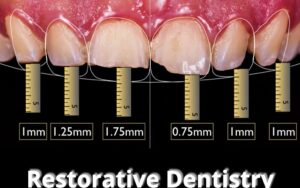 In restorative dentistry, broken and missing teeth are replaced and recreated. The processes are assistive in improving dental health and functioning. The most popular dental restorations are crowns, bridges, and implants.
In restorative dentistry, broken and missing teeth are replaced and recreated. The processes are assistive in improving dental health and functioning. The most popular dental restorations are crowns, bridges, and implants.
What is Restorative Dentistry?
Restorative dentistry involves restoring lost or damaged teeth to help restore their function and appearance, as well as overall oral health. Procedures or operations involved in this include fillings, crowns, bridges, implants, and dentures, and the purpose of this procedure is to treat the conditions such as cavities, tooth decay, trauma, or loss of teeth.
It is so that chewing, speaking, and fixing the looks can be enhanced, and that additional dental issues can be avoided. Restorative dentistry differs from cosmetic dentistry by focusing primarily on restoring function, though it often provides cosmetic benefits as well.
Why is restorative dentistry important?
Restorative dentistry has played a vital role in enhancing oral health. It helps to rebuild teeth that are rotten and decayed, therefore maintaining oral hygiene. Restorative dentistry is a treatment approach designed to restore your smile and improve comfort while chewing, speaking, and eating. Addressing these issues early in life increases the likelihood of maintaining healthy, functional teeth for many years to come.
Treatment Details
Types of dental restoration
Depending on dental needs , there are various forms of dental restorations available.
Fillings
When bacteria consume your tooth enamel and create a hole in it, the condition is known as a cavity. Dental fillings are mostly used in small cavities. During the procedure, the dentist removes the infected portion of the tooth by carefully scraping it away, then fills the cavity with a tooth-colored composite material. It also prevents the development of tooth decay and reduces the likelihood of further damage.
Crowns
Professional dentists use dental crowns to fill large cavities and replace broken teeth. A crown, also known as a cap, fits over the entire tooth. The dentist has to part of your tooth enamel to be able to accommodate a dental crown.
Inlays and onlays
There are cases where a cavity is small enough not to require a crown, but it is too large to be filled with a filling. A dentist will apply an inlay / onlay. Such reconstructions are identical to your natural tooth holes, just as in a puzzle. Your professional dentist bonds them in a manner that they are forever in place. Nonetheless, Inlays and onlays are alike. All through, there is an inlay in the space between the cusps of your teeth, and at least one cusp is also covered with an onlay.
Bridges
A dental bridge may be used to replace a row of missing or lost teeth replace a row of missing teeth or a row of lost teeth. Bridges are the dental crowns attached to fake teeth, which fill the space between natural teeth.Your dentist will reshape the teeth on either side of the gap and securely bond the dental bridge to your natural teeth. The dental crowns fit over your natural teeth, and the artificial teeth span the gap in between them.
Dentures
These are another traditional option for teeth replacement. A full arch of lost teeth is replaced with complete dentures. Partial dentures are used in place of some of the missing teeth in various parts. Dentures lie on the surface of your gums, and the jawbone beneath them supports them.
Root canal therapy
Root canal therapy is required when the tooth pulp is affected by the bacteria through the cavity or crack, thus subjecting the individual to pain and infection. Gutta-percha is inserted into the canals, the tooth is cleaned and disinfected, and the infectious pulp is removed as part of this procedure. The tooth is then filled, and a crown is placed on it as an extra protection.
A Note from Bel Air, MD Dentist
Saving your health and restoring your pulverized teeth is the primary goal of restorative dentistry that Bel Air, MD dentists practice. We understand that undergoing a dental procedure—especially for the first time can feel uncomfortable. However, addressing dental issues early can help prevent more serious complications down the line, saving you time, discomfort, and stress. Your long-term oral health and comfort will always remain our top priority.






